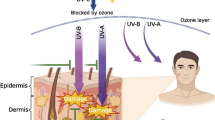Summary
To study whether fluorescent lighting at work might increase carcinogenesis, hairless mice were exposed to a bank of six 36 W standard fluorescent lamps (neutral-white) every workday for 8 h at an illuminance level of 1000 lx. For comparison, other mice were exposed to UVB radiation or to simulated solar radiation.
In experiment A the animals were irradiated for 6 weeks prior to the application of 7,12-dimethyl-benzanthracene once and — following an interval of 2 days for 10 weeks after DMBA application. The number of blue nevi and papillomas was enhanced by exposure to all spectra 10 weeks after chemical tumor induction.
In experiment B the animals were irradiated for 6 weeks prior to the transplantation of UV-induced fibrosarcoma cells from syngeneic mice into the dorsal and ventral skin. Within the following 4 months fibrosarcoma developed in the dorsal skin exposed to the fluorescent lighting and to the UVB radiation, as well as in the non-irradiated ventral skin of 10–20% of the mice.
The results suggest that fluorescent lighting as used in certain work environments may increase carcinogenesis caused by other factors.
Similar content being viewed by others
References
Beral V, Shaw H, Evans S, Milton G (1982) Malignant melanoma and exposure to fluorescent lighting at work. Lancet II:290–293
Bowen RG, Brody NJ (1983) Increased susceptibility to B 16 melanoma, tumor takes induced by UV-light. J Invest Dermatol 80:370 (abstract)
Burnet FM (1970) Immunological Surveillance. Pergamon Press, Oxford, London, New York
Davies RE (1978) Interaction of light and chemicals in carcinogenesis. Natl Cancer Inst Monogr 50:45–50
De Fabo EC, Kripke ML (1979) Dose response characteristics of immunologic unresponsiveness to UV-induced tumors produced by UV irradiation of mice. Photochem Photobiol 30:385–390
De Fabo EC, Kripke ML (1980) Wavelength dependence and doserate independence of UV radiation induced immunologic unresponsiveness of mice to a UV-induced fibrosarcoma. Photochem Photobiol 32:183–188
De Gruijl FR, van der Leun JC (1983) Follow up on systemic influence of partial pre-irradiation on UV-tumorgenesis. Photochem Photobiol 38:381–383
Epstein JM, Epstein WL (1962) Carcinogenic effect of ultraviolet light on DMBA tumor initiation in albino mice. J Invest Dermatol 39:455–460
Freeman RG, Knox GM (1964) Influence of temperature on ultraviolet injury. Arch Dermatol 89:858–864
Kripke ML (1977) Ultraviolet radiation and tumor inmmunity. J Reticuloendothel Soc 22:217–222
Kripke ML (1979) Speculations on the role of ultraviolet radiation in the development of malignant melamona. J Natl Cancer Inst 63:541–545
Kripke ML, Fisher MS (1976) Immunologic parameters of ultraviolet carcinogenesis. J Nat Cancer Inst 57:211–215
Maxwell KG, Elwood JM (1983) UV radiation from fluorescent lights. Lancet II:579
Morison WL (1985) the effects of UVA radiation on immune function. Photochem Photobiol 41:6S (abstract)
Pasternack BS, Dubin N, Moseson M (1983) Malignant melanoma and exposure to fluorescent lighting at work. Lancet I:704
Rigel DS, Friedman RJ, Levenstein MJ, Greenwald DI (1983) Relationship of fluorescent lights to malignant melanoma. Another view. J Dermatol Surg Oncol 9:836–838
Roberts LK, Daynes RA (1980) Modification of the immunogenic properties of chemically induced tumors arising in hosts treated concomitantly with ultraviolet light. J Immunol 125:438–447
Ronchi LR, Bodmann HW (1983) Fluorescent lighting, skin cancer and malignant melanoma. CIE Journal 2:58–59
Stenbäck F (1975) Studies on the modifying effect of ultraviolet radiation on chemical skin carcinogenesis. J Invest Dermatol 64:253–257
Author information
Authors and Affiliations
Rights and permissions
About this article
Cite this article
Wiskemann, A., Sturm, E. & Klehr, N.W. Fluorescent lighting enhances chemically induced papilloma formation and increases susceptibility to tumor challenge in mice. J Cancer Res Clin Oncol 112, 141–143 (1986). https://doi.org/10.1007/BF00404397
Received:
Accepted:
Issue Date:
DOI: https://doi.org/10.1007/BF00404397




